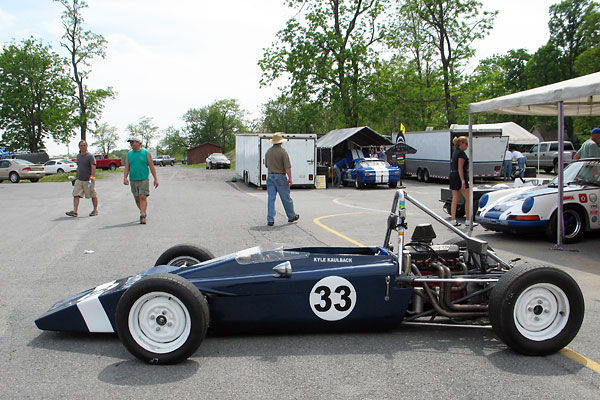
Kyle Kaulback's 1970 Lotus 61MX "F3" Formula Ford Racecar
Owner: Kyle KaulbackCity: Bethel Pennsylvania
Model: 1970 Lotus 61MX
Engine: Ford Kent 1600cc four cylinder
Restored by: Bill Dolson Racing
Race prepared by: Powerslide Motorports
What is a Lotus 61MX?
When Formula Ford started in 1967, Lotus was prepared. Their Type 51 was the first car introduced for
the formula. Other constructors quickly followed -
Alexis,
Macon,
Merlyn,
Royale,
Titan,
and a slew of others - but in the early years no other Formula Ford constructor had remotely
comparable resources or such a gilded reputation. So it should be no surprise that Lotus sales were
brisk... for awhile. Although Lotus was quickest off the mark, it wasn't long before their success
in Formula Ford faltered. Lotus continually updated and improved their product, and how they
marketed it, but to no avail. In just four years Lotus dropped out of building Formula Fords
altogether.
Eight distinct Lotus Formula Fords model designations exist: 51, 51a, 51b, 51c, 61, 61M, 61MX
and 69, and total production tallied up to almost three hundred cars. Lotus 51 and 61
series Formula Fords are all cut from similar cloth, and the more specific model designations merely
define stages in a continuously evolving progression. On the other hand, the
Type 69 is distinctly different: much more elaborate and expensive by design. Only about twenty
Lotus 69 Formula Fords were built.
In an earlier article, we presented a Lotus
51c's design and construction in detail. Here we'll look at a particularly original 61MX and see
some significant design differences. The most obvious difference between 51 series and 61 series cars
is definitely styling. The 51 was basically shaped like a cigar. For the Type 61, Lotus instead made
a styling decision to mimic the wedge shape of their famous Type 56 turbine-powered Indycar.
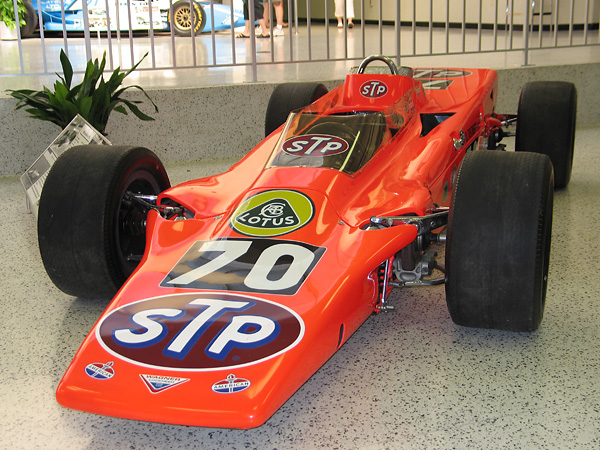
Graham Hill's Turbine-Powered Lotus Type 56 (1968 car #70)
photographed at the Indianapolis 500 Hall of Fame Museum by Curtis Jacobson.
Regretably, the wedge shape simply didn't work in Formula Ford. The new body proved less
streamlined and also larger in cross-section than its predecessor and indeed most competitors.
Furthermore the new body hampered cooling system performance. Customers tried to rectify this
by cutting all sorts of vents in the bodywork rearward of the radiator. Lotus even mailed out
specific instructions with sketchs and dimensions showing how best to improve the size and
profile of a factory-cut vent under the 61's nose. (Forsooth, under the nose!)
It therefore shouldn't be a surprise that the main differences between the original 61 and its M/MX
variants are aerodynamic fixes. The one-piece nose/cowl was redesigned lower and then lower again
(ultimately ~4" lower at the firewall.) On the MX, the engine cover was finally just taken away.
Many savvy customers had already found that 61s were faster without their engine covers.
Just what made the 61MX different from the 61M? The most certain answer is that an "X"
was added to the chassis plate and the code "F3" (for Formula Three) was inscribed in the space
where "FF" rightfully belonged.
We must pause now to explain (a) that the 51c was a transition model and that (b) most 51c cars
were exported to the United States, whereas exports of the 61 were temporarily held back. In
point of fact the 51c and the first generation of the 61-series were built concurrently, and
under the skin there are substantial similarities. Compared to the earlier 51-series models,
these frames were quite noticeably stiffer due to several added tubes and improved triangulation.
See photos and captions below. The 51c and the 61 series also shared an improved rear hub
carrier (now reversible left to right), stouter rear brake calipers, and an improved
trailing link arrangement.
Enjoying this article? www.BritishRaceCar.com is partially funded through generous support from readers like you!
To contribute to our operating budget, please click here and follow the instructions.
(Suggested contribution is twenty bucks per year. Feel free to give more!)
On the other hand, all 51 variants had a rounded cowl hoop whereas all 61 variants had a
squared-off one to suit the new bodywork. All 51 variants had their steering racks mounted
on horizontal bolts, whereas all 61 variants had their steering racks mounted on vertical
bolts - the latter being easily shimmed to eliminate bump steer as required. All 51 variants
had integral reservoir master cylinders; all 61 variants featured easy to spill on the driver
remote reservoirs.
One of Lotus' strengths was their strong network of suppliers and potential commercial
partners. For example, during Type 61 production Lotus included Ford Kent engines that were
prepared for racing by Holbay Racing Engines. Lotus guaranteed that "Lotus-Holbay" engines
would produce within two percent of 105bhp at 5850rpm. Maximum torque output was rated
108lb-ft at 4400rpm. Incidentally, Holbay also provided performance engines for Lotus to
offer in Lotus Seven S3 SS sportscars.
When Lotus finally decided to exit the market, their remaining inventory was transferred
to Caterham Car Sales who became the exclusive distributor for 61M and 61MX Formula Fords as
well as remaining Lotus Seven sports cars. A 1971 Caterham Car Sales magazine advertisement
read: "Sole Concessionaires Lotus Formula Ford. 61M Rolling chassis from £495.
61R to 1972 regulations. Torino tyres, Holbay engine, from £1,050. Full spares service.
Also available for Formula Fiat, Super Vee, etc. Specialist export freighter service."
(Note: this ad is the only reference we've found to a "61R" variant.)

LOTUS - Norwich, England
Unit No. 61MX-F3-214, Engine No. LH407, Transmission No. LC418Mk8
Kyle's Lotus 61MX
Chassis 61MX/F3/214 was originally sold by Lotus Racing Ltd. to an American racer who campaigned it for
several years in Sports Car Club of America races. The car is a unusual in that serial numbers
stamped into the frame, on the chassis plate, on the engine cover, and on the Hewland gearbox
all match original factory records. It is believed by its owner to be one of the most "original"
Type 61s in existence. 61Mx/F3/214 was restored by Bill Dolson Racing and is now maintained
by Powerslide Motorports. It's owned and enthusiastically vintage raced by Kyle Kaulback.
Features and Specifications
| Engine: | 1.6L Ford four-cylinder engine (Lotus-Holbay model "LH/105").
Weber 32/36 DGV carburetor.
K&N gauze air filter.
Bosch distributor (with breaker points).
Bosch blue ignition coil.
Mallory Pro-Wire Silicone / Stainless Steel 8mm spark plug wires.
Dry sump lubrication system with rear mounted reservoir.
Pace oil pump.
Purolator engine oil filter. |
| Cooling: | crossflow radiator (with 3-row core).
Through the frame coolant plumbing.
Custom fabricated aluminum swirl tank.
Custom fabricated aluminum coolant overflow tank.
10-row engine oil cooler. |
| Exhaust: | stainless steel four-into-one headers. |
| Transaxle: | Hewland Mk8 four speed.
Open differential.
9.31 crown wheel and pinion (i.e. 3.44:1 final drive ratio.)
Metalastic rubber "doughnuts" on the halfshafts. |
| Front Susp.: | unequal length wide-based wishbones.
Triumph (Alford & Alder, forged) uprights.
Spax double adjustable aluminum bodied coilover shock absorbers.
Adjustable anti-sway bar. |
| Rear Susp.: | inverted lower wishbones, single top links, and twin adjustable trailing links.
Proprietary Lotus magnesium uprights.
Spax double adjustable aluminum bodied coilover shock absorbers.
Adjustable anti-sway bar. |
| Brakes: | (master) dual Girling master cylinders with remote reservoirs and adjustable bias bar. (front) Girling 14LF calipers. 9.25" solid rotors. (rear) Girling 14LF calipers. 9.75" solid rotors. |
| Wheels/Tires: | Ford 13x5.5 steel disc wheels.
Dunlop Racing "Formula Ford" tires (135/545-13 CR82 front, 165/580-13 CR82 rear). |
| Electrical: | Tilton Super Starter. |
| Instruments: | (left to right)
Smiths coolant temperature gauge (30-110C),
Smiths Chronometric rev counter (500-9000rpm),
Smiths oil pressure gauge (0-100psi).
|
| Fuel System: | under seat fuel cell (4 gallon).
FF1600 fuel pump with push-on fittings. |
| Safety Eqmt: | Schroth Racing six-point cam-lock safety harness.
Phoenix Halon-based fire suppression system. |
| Weight: | ~1000 pounds. |
| Racing Class: | Formula Ford |
Engine Installation
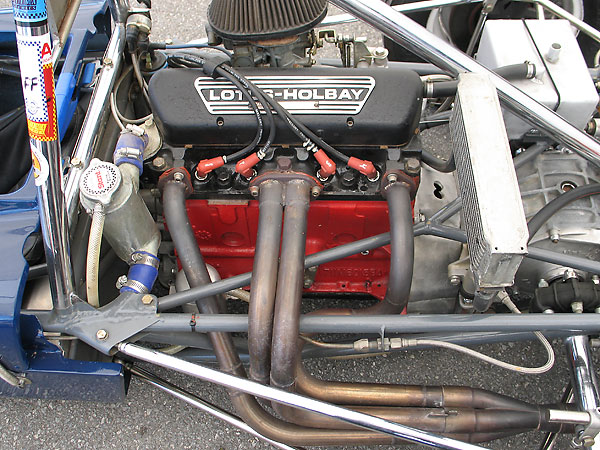
Lotus-Holbay aluminum valve cover.
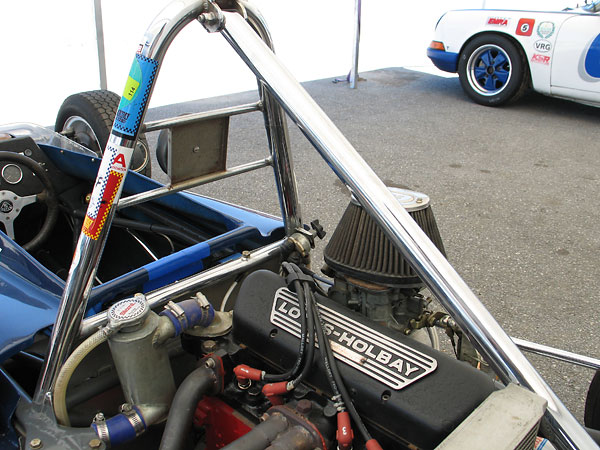
Holbay Racing Engines was founded by John Reid in ~1958. The name "Holbay" came from their location
on Hollesley Bay. It would be largely correct to characterize Holbay as a direct rival to Cosworth in racing
classes below Formula One. Holbay offered performance parts of their own design for Ford engines
including Lotus Twin-Cams, high end engine building and tuning, and engineering services for quite a
diverse and prestigious list of race car teams and manufacturers including especially Brabham, Lotus,
and Fiat. Holbay still exists, but is a shadow of itself since the untimely death of John Reid in 1992.

Custom fabricated aluminum swirl tank.
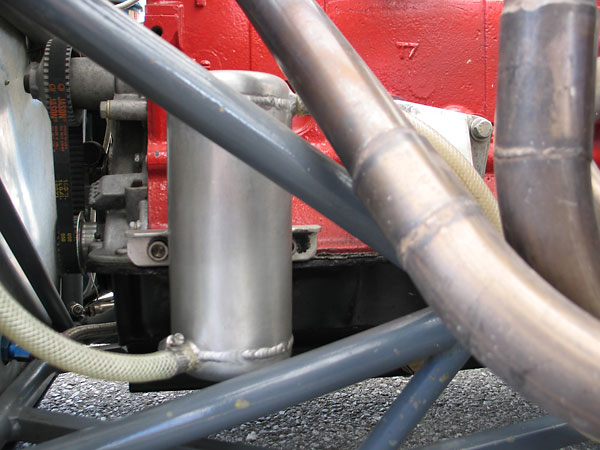
Custom fabricated aluminum coolant overflow tank.
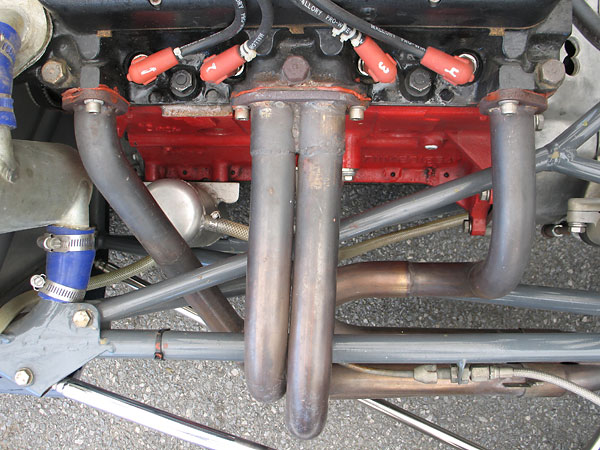
Stainless steel four-into-one exhaust header.
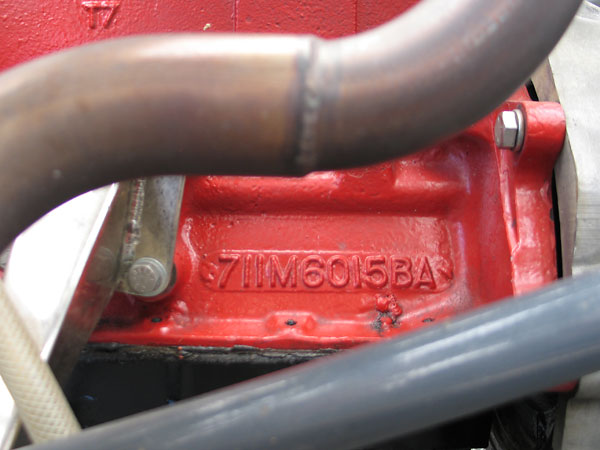
711M6015BA: a 1600cc tall engine block with big bearing caps.

10-row aluminum oil cooler on a robust mounting bracket.
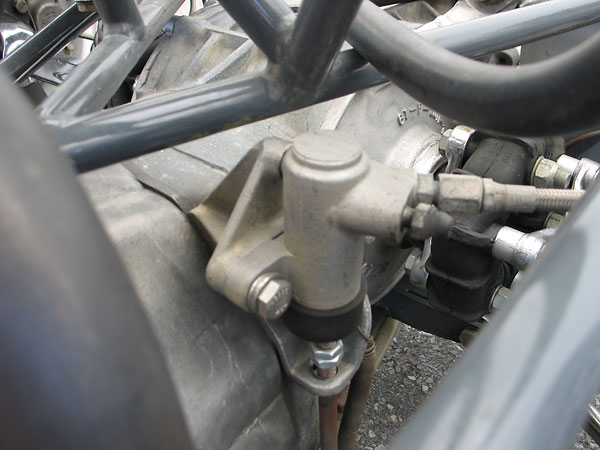
Girling clutch slave cylinder.
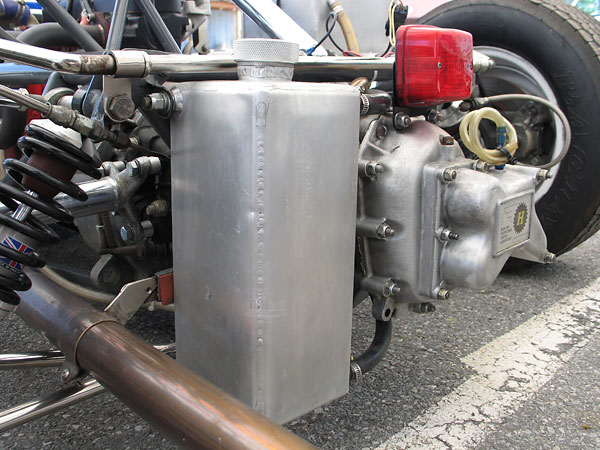
Rear mounted engine oil reservoir.
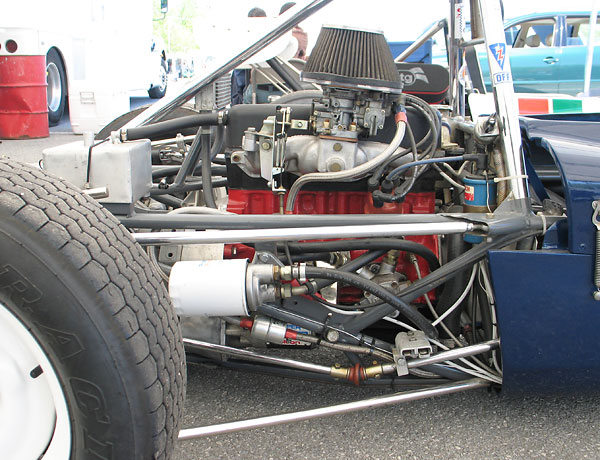
Purolator engine oil filter.
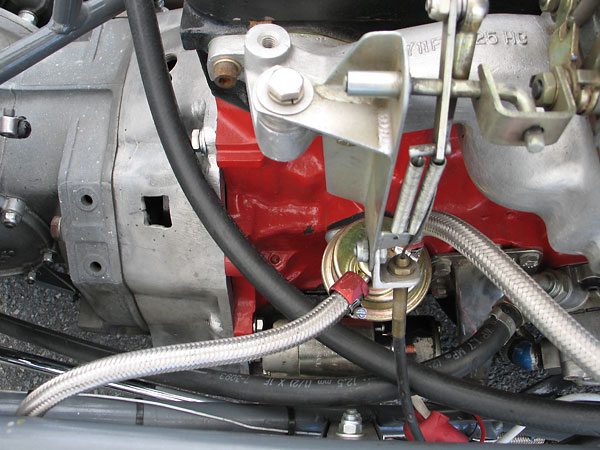
Mechanical fuel pump, throttle cable/linkage, and lightweight/modern Tilton gear reduction starter.

The name "Loyning" stamped into this intake manifold indicates that this engine was once rebuilt by
Arnie Loyning of Portland Oregon. Loyning has been a premier FF engine builder since about 1976.
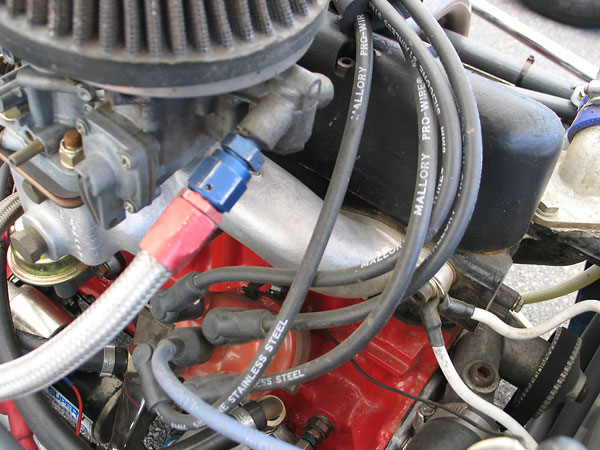
Bosch distributor and Mallory Pro-Wire Silicone / Stainless Steel 8mm spark plug wires.
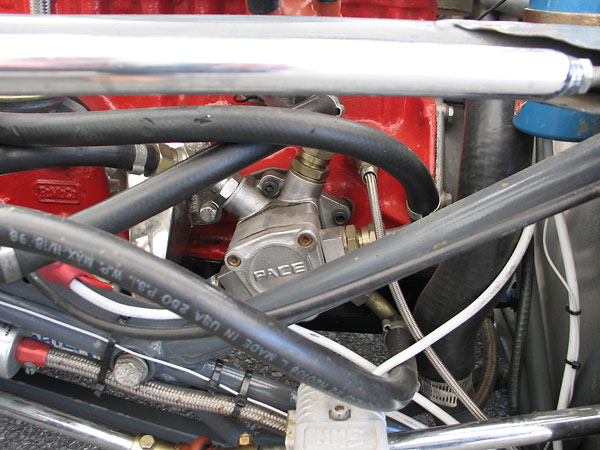
Pace Products is one of the handful of companies that manufactures the special dry sump oil pumps
used on Formula Fords. Other companies, including car constructors, have put their names on Pace
pumps for marketing purposes. Pace was founded by ex-Lotus Chief Mechanic David Lazenby after
his own Formula Ford manufacturing business, Hawke Racing Cars, failed.

Hewland Mk8 four speed with 9x31 crown wheel and pinion producing a 3.44:1 final drive ratio.
Front Suspension
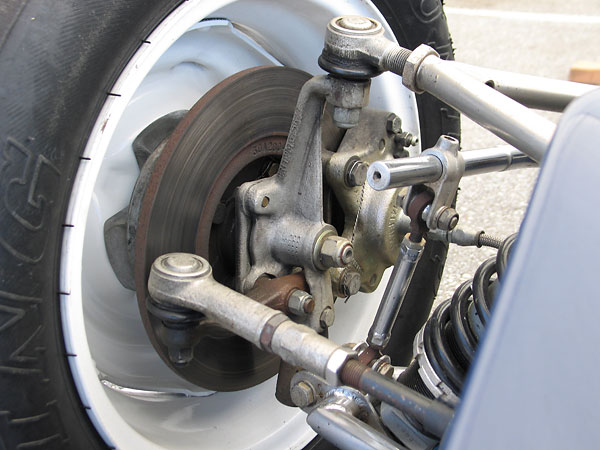
Alford & Alder forged uprights (as also used on countless Triumph production cars.)
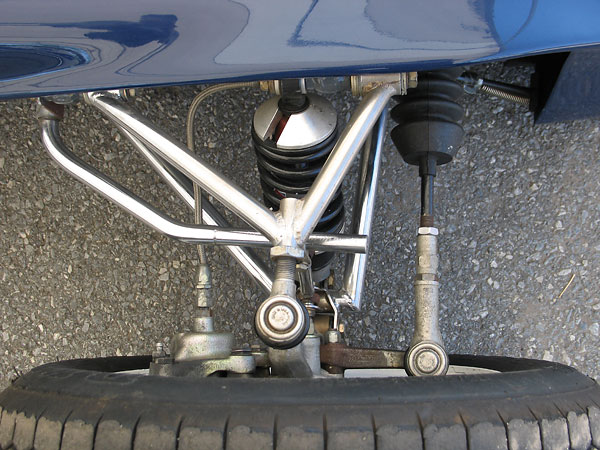
Ordinary dual wishbone front suspension. Note that sealed tie rod ends are used two places in lieu
of Heim joints, which makes adjustment less convenient. On the wishbone, length adjustment is
limited to increments defined by thread pitch. At the steering link, tie rod ends aren't easily
shimmed up or down to adjust bump steer. However, three big practical advantages of tie rod
ends are (1) low cost, (2) vastly superior durability, and (3) greater range of motion before binding.

At the inboard side, simple bushes in lieu of Heim joints also trade tuning ease and accuracy for
cost and durability. From the early 1970's, most Formula Fords came standard with Heim joints.
In the 1980s, Teflon fabric-lined Heim joints would become widely available. These new products
proved a good value because they greatly improved service life.
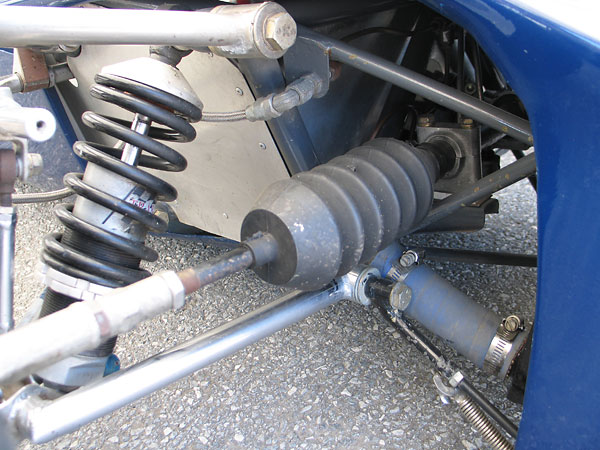
Type 61 steering racks mount on vertical bolts. They can be shimmed up or down to eliminate bump steer.
Enjoying this article? www.BritishRaceCar.com is partially funded through generous support from readers like you!
To contribute to our operating budget, please click here and follow the instructions.
(Suggested contribution is twenty bucks per year. Feel free to give more!)
Rear Suspension

Inverted lower wishbones, single top links, and twin adjustable trailing links...
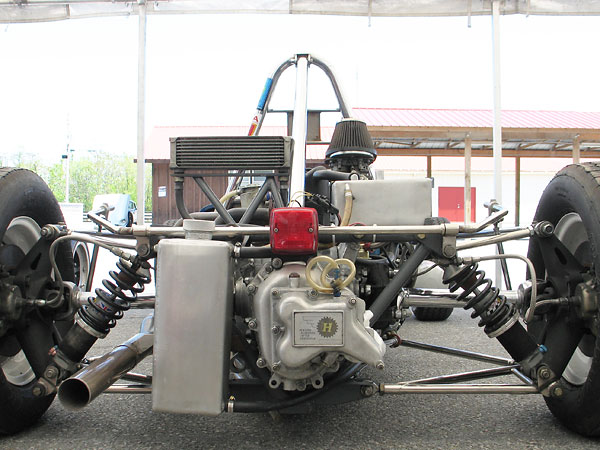
The adjustable anti-sway bar is mounted the period-correct way: on simple fabricated steel brackets.
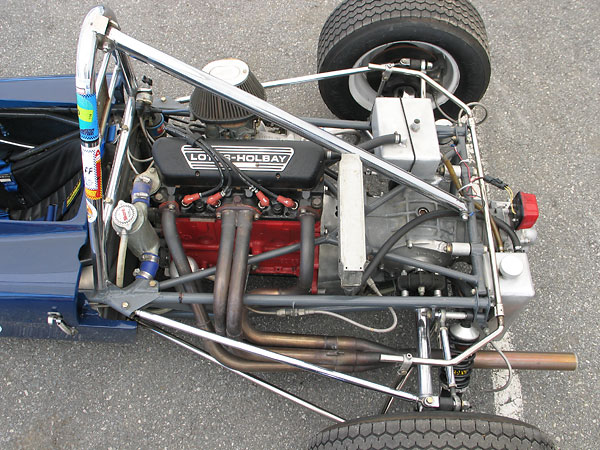
Upper rear trailing links are mounted over four inches higher on the Lotus 61
compared to where they had been on the original Lotus 51.
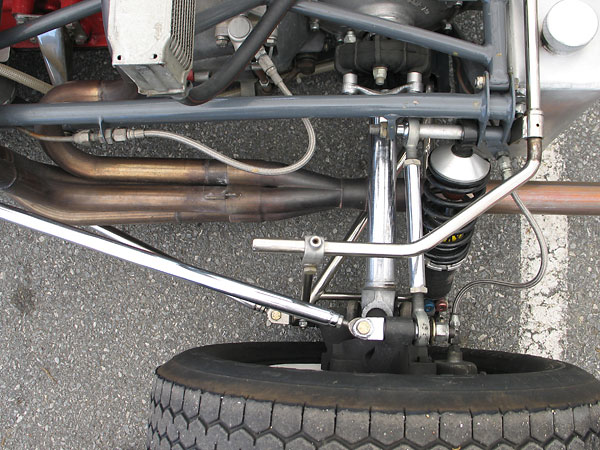
Metalastic (a.k.a. Rotoflex) reinforced rubber donuts absorb length variation while
simultaneously accomodating angle variation on the spinning driveshafts.
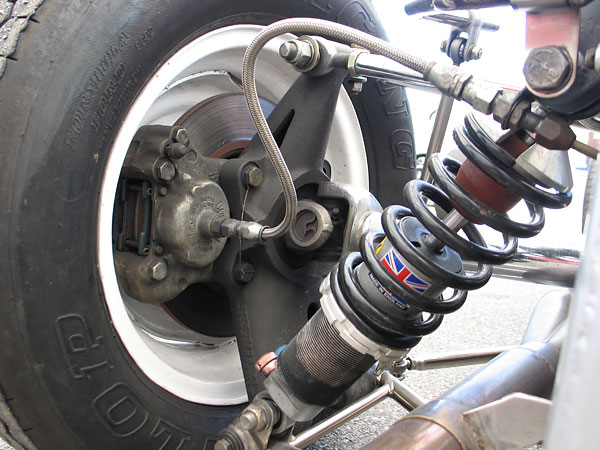
These Spax shock absorbers are British. Their aluminum bodies weren't originally allowed
in Formula Ford. This car probably came from Lotus with steel-bodied Armstrong shocks.
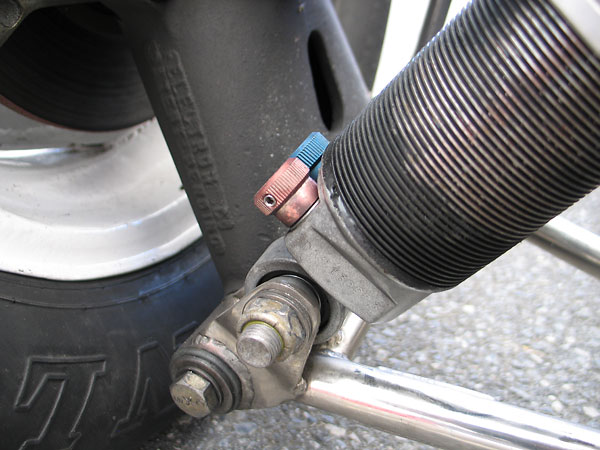
With separate knobs for adjusting compression and rebound valving, this is called a double adjustable
shock absorber. When shocks have just one knob, they're called single adjustable (duh). On single
adjustable shocks, adjustment affects both compression and rebound but not equally. Note also
the word "Electron" cast into the hub carrier behind. Electron is a trademark for a magnesium alloy.
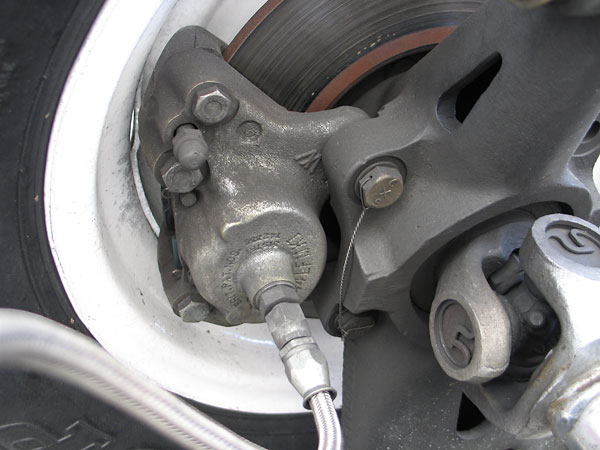
Girling 14LF MKI brake caliper. These are stouter than the 12SP calipers fitted on the rear of
previous Lotus Formula Fords and most competitor-built cars. Mounting lug spacing between
the two caliper types are different.

Lotus worked with Hewland to optimize transaxle side plates for their chassis configuration.
The Lotus 69 would be very different in this area; its frame didn't extend beyond the halfshafts.
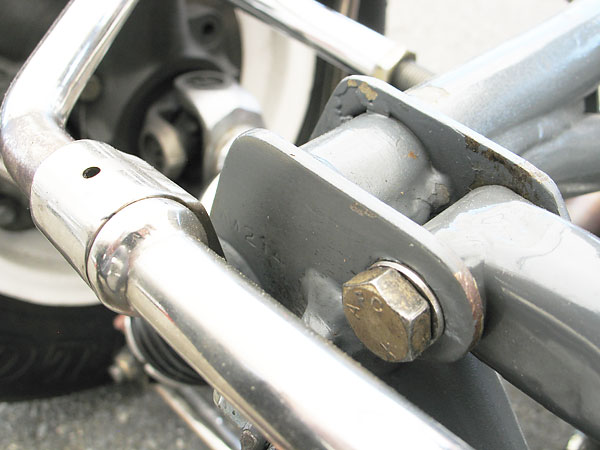
Arch Motors stamped their serial number on the frame here. It reads: AM214.
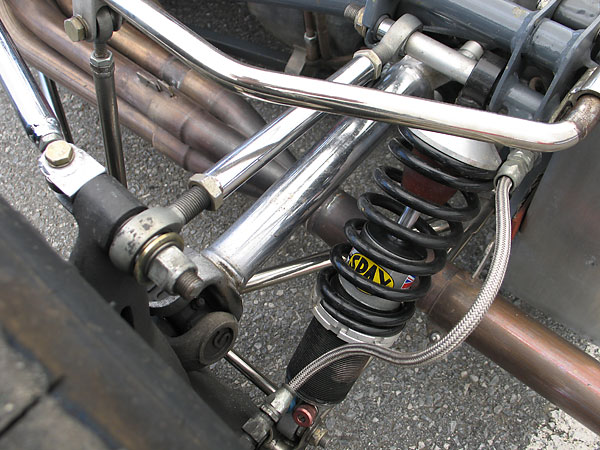
When Heim joints aren't mounted in double shear, it's smart to use a large washer
on the outboard side. Otherwise, on impact the ball may rip out of its socket.
Interior
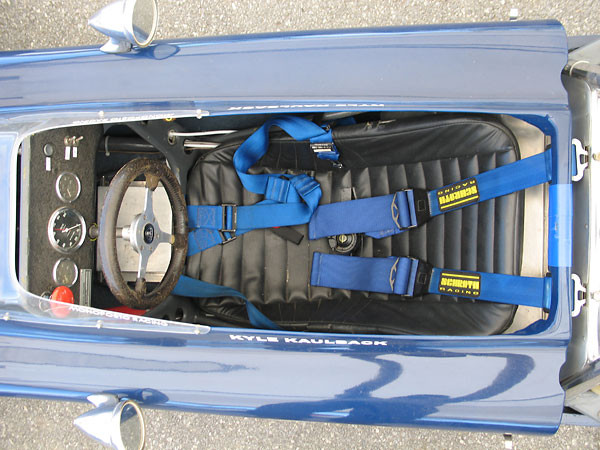
A comfortable looking seat, and a Schroth Racing six-point cam-lock safety harness.
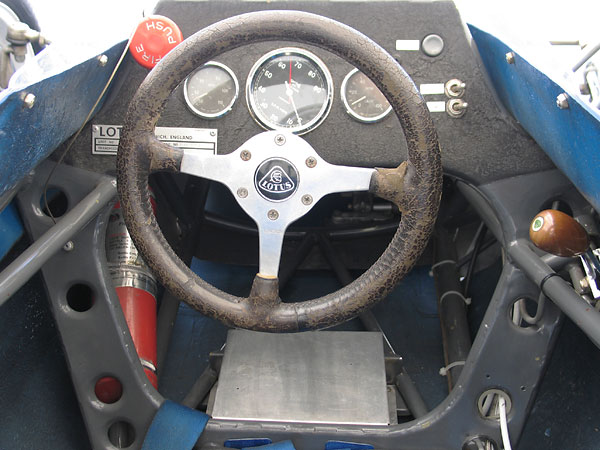
Lotus' distinctive perforated scuttle, but with a flat top for a change.
Note also the period-correct Intertech steering wheel.
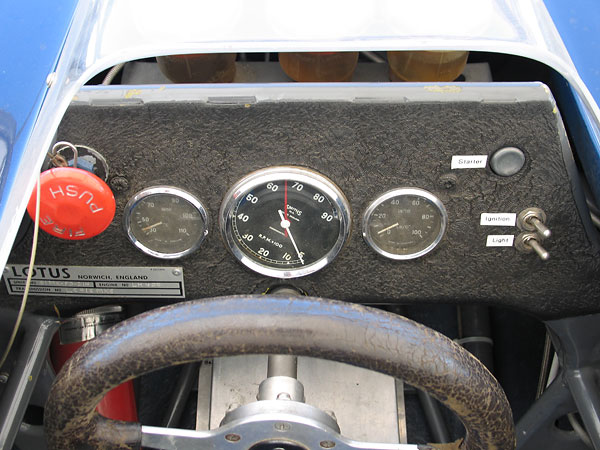
Smiths coolant temperature gauge, chronometric rev counter (9000rpm), and oil pressure gauge.
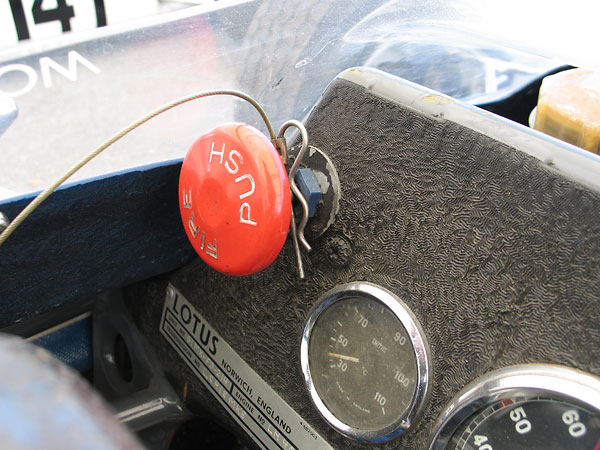
A hair pin prevents accidental engagement of the fire suppression system. (Note metric gauge face.)
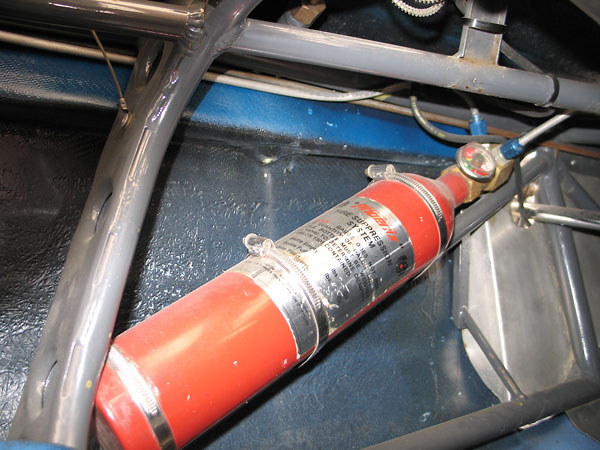
Phoenix Halon-based fire suppression system.
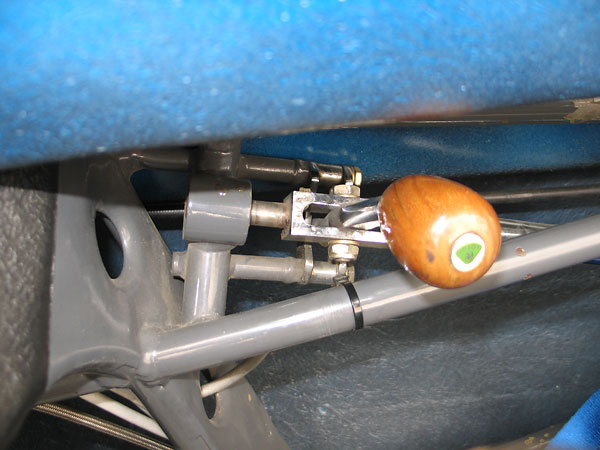
Early 61s had a bulge in their bodywork for extra hand room around the gear selector.
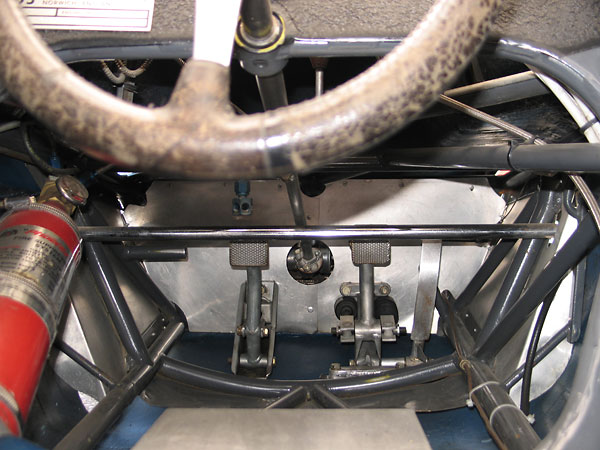
As with the Lotus 51, Lotus 61 drivers rest their heals on a strip a steel.

Telescoping steering column.
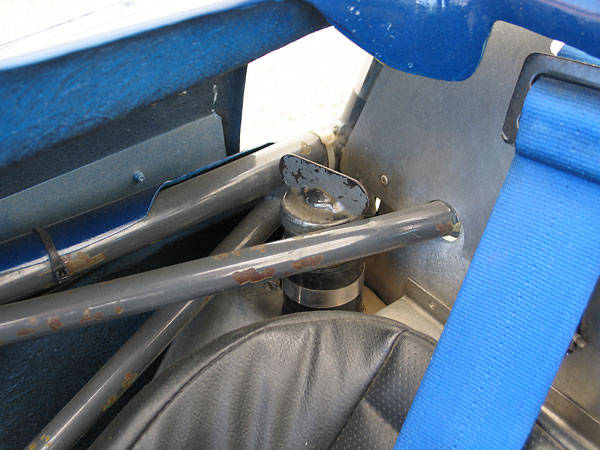
Wedge shaped under-seat fuel tank.
Exterior
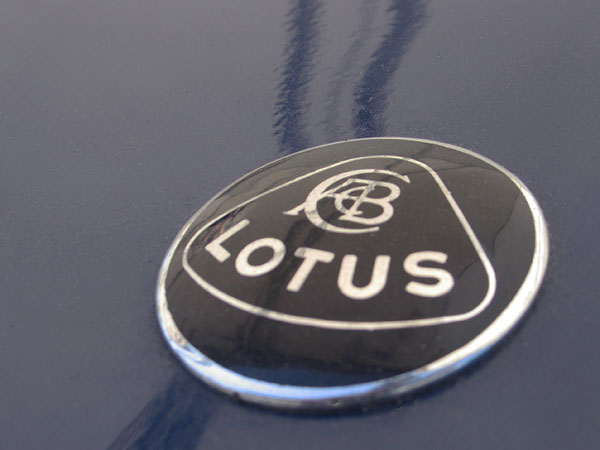
The familiar Lotus emblem.
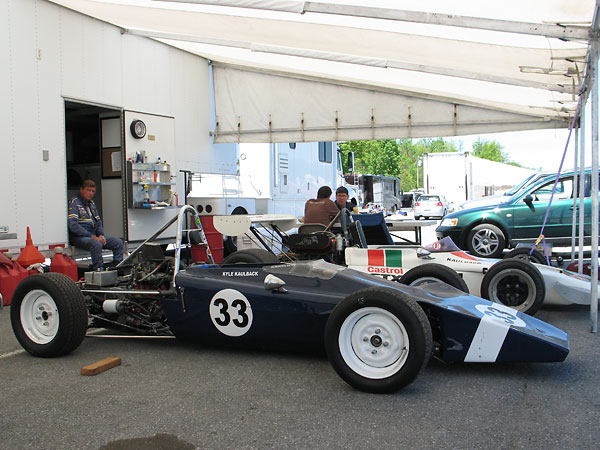
Powerslide Motorports provides trackside support as well as preparation and maintenance services.

Kyle Kaulback has a very impressive car collection! We'll feature his spectacular
Lotus 69 Formula Two racecar in a future BritishRaceCar.com article.
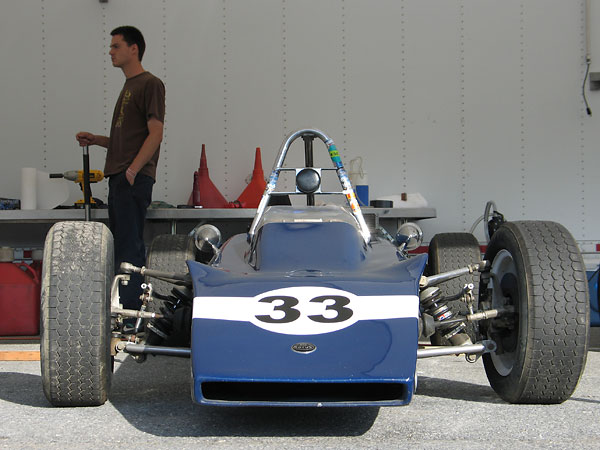
A large photo of a Lotus 61 painted pale olive green with a mustard yellow stripe dominated
the January 10, 1969 cover of Autosport Magazine, "Britain's Motor Sporting Weekly".
The tagline read simply: "Win this new Lotus FF - European Rally Survey".
One has to wonder if giving cars away was an effective strategy for Lotus.
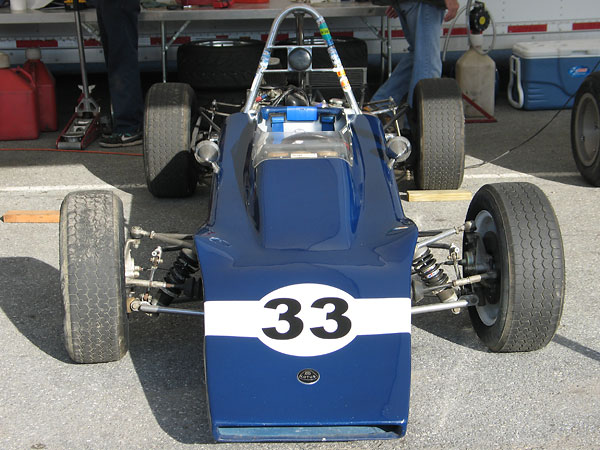
Lotus magazine ads for the Type 61 Formula Ford boldly announced "The Shape of Things To Go".
This obviously pre-dated Triumph's famous TR7 "The Shape of Things To Come" ad campaign.

With these remotely mounted reservoirs, brake and clutch fluid levels are easier to check,
but not really easier to top off. Be careful. Any leaks or spills might end up on the driver.
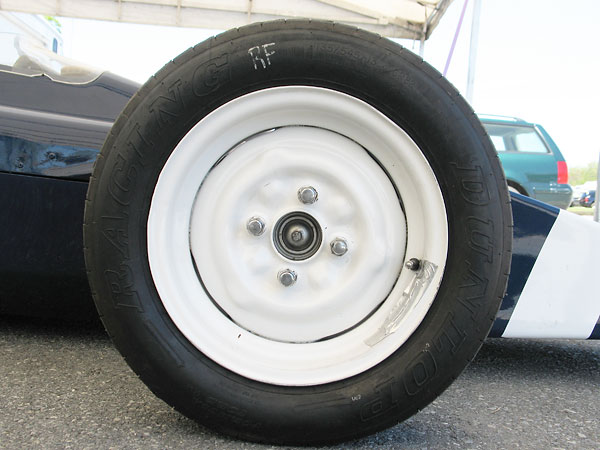
13x5.5 steel disc wheels.
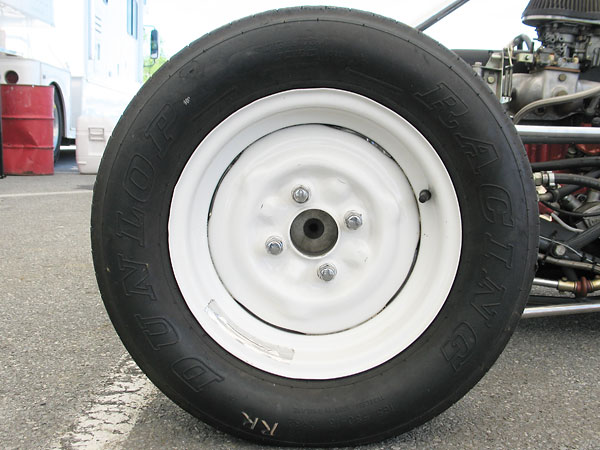
Dunlop Racing "Formula Ford" tires (135/545-13 CR82 front, 165/580-13 CR82 rear).
All photos shown here are from April 2010 when we viewed the car at VRG's Jefferson 500
at Summit Point Motorsports Park, West Virginia. Photos by Curtis Jacobson for BritishRaceCar.com,
copyright 2011. All rights reserved.
| If you liked this article, you'll probably also enjoy these: | |||||
 |
Dick Leehr 1968 Lotus 51c |
 |
Dave Fairchild 1969 Merlyn 11A |
 |
Kyle Kaulback 1971 Lotus 69 FB |
| You're invited to discuss anything you've seen here on The British Racecar Motorsports Forum! | |||||
Notice: all the articles and almost all the photos on BritishRacecar.com are by Curtis Jacobson.
(Photos that aren't by Curtis are explicitly credited.) Reproduction without prior written permission is prohibited.
Contact us to purchase images or reproduction permission. Higher resolution images are optionally available.


